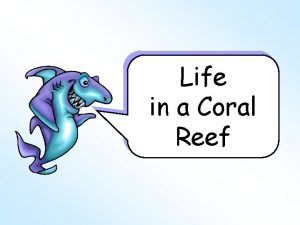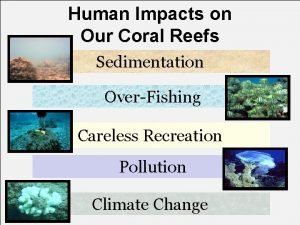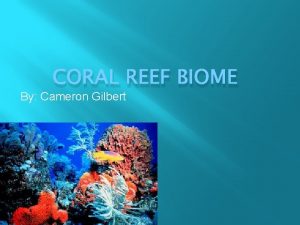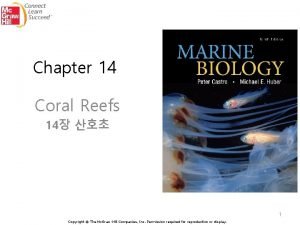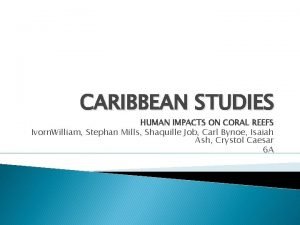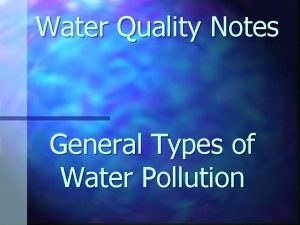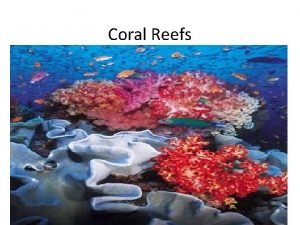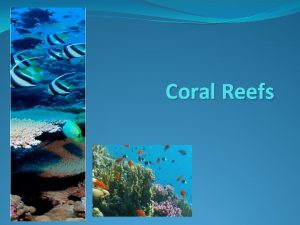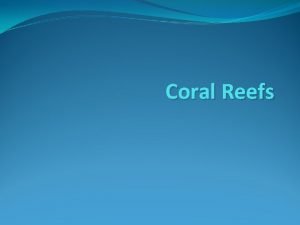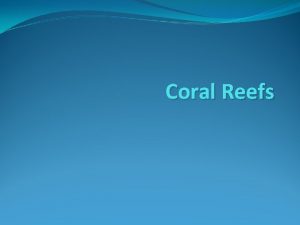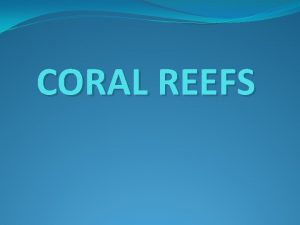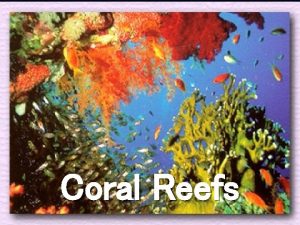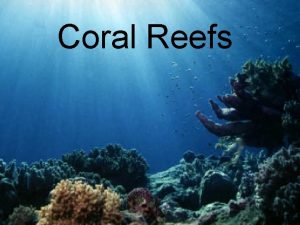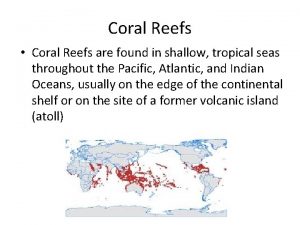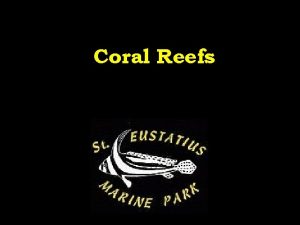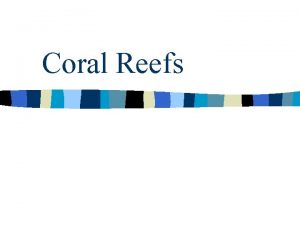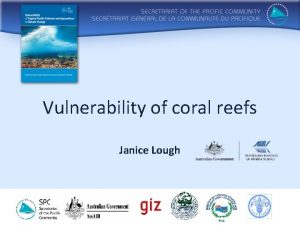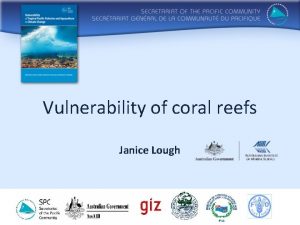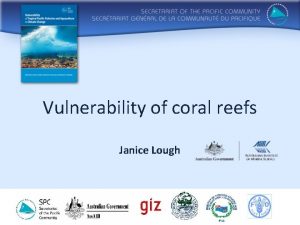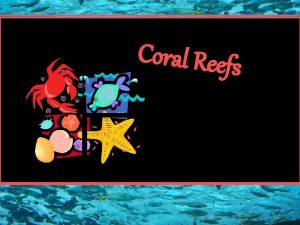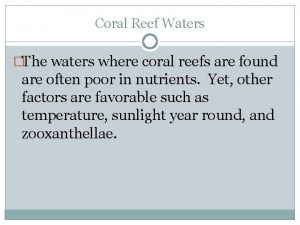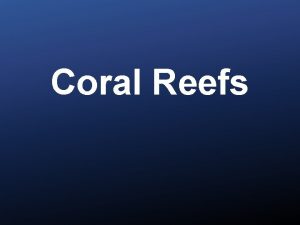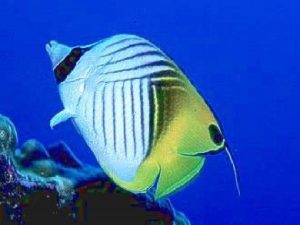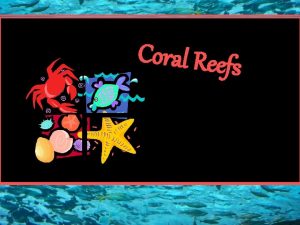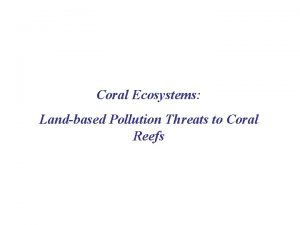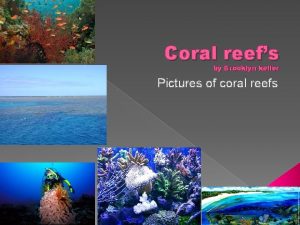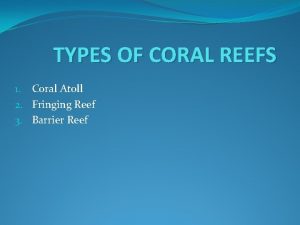Coral reefs Coral reefs One of the most









































- Slides: 41

Coral reefs

Coral reefs • One of the most biological diverse and productive ecosystem • Found in warm, clear and shallow tropical oceans • On Ca. CO 3 substrate deposited by reef building corals (50% of all Ca deposit in the sea) and other calcified organisms. • Provide shelters and food to fish

Global distribution of coral reefs (Osborn Fig. 11. 10)

Higher coral generic richness in Indo-Pacific (and accompanying fish diversity)

Highest diversity of corals in Indo-Australian archipelago

Figure 4. Analysis of factors influencing biodiversity of coral reefs, illustrated by the percent variation in taxonomic composition of fish and coral assemblages explained by habitat area, longitude, and latitude. (Bellwood & Hugh 2001, Science 292: 1532 -1535)

Types of reefs: fringe, barrier, atolls Atolls “final stage of tropical island development” (Charles Darwin 1942, Structure and Development of Coral Reefs”)

Reef structure

Sandy flats dominated by Parchment worms (Chaetopterus spp. )

Types of reef building corals

Brain corals With extended polyps

Coral anatomy (Osborn Fig. 11. 2)

Coral Anatomy: mutualism between corals and Zooxanthellae algae

Growth rings in corals

Mutualism between clown fish and sea anemone • Clown fish is coated with the same mucous as anemone. • Fish brings food. • Anemone protect fish.

Why is diversity so high in coral reefs and rain forest? • On nutrient poor water • High level of mutualism and symbiosis • High productivity and high rates of nutrient cycling • Finely divided niches • Control by herbivores and competitions?

Limestone outcrops in S. Florida: >10, 000 yr old land rich in endemic Ca-loving herbaceous plants Miami rock ridge & upper keys: Oolitic limestone, precipitated in sallow sea supersaturated with Ca. CO 3 Lower keys: coral origin

Florida geology: 140 yr old lime stone, 14, 000 -9, 000 yr old corals to make the Keys

Florida Keys

Oolite: limestone made in coral reefs

Florida marsh distribution • North: sink hole origin and untable. • Kissimmee river basin: where the land sagged slightly from dissolution of underlying limestone. • Lake Okeechobee: water dammed by the sedimentation in the southern rim. • Northern Everglades: river of grass, following the gradual elevational gradient to SW. • Southern Everglades: freshwater lens pushed up by the saltwater underneath.

Fresh water lens under coral island the Everglades

Tropical estuary: • Sea grass beds • Mangroves, mudflat, marshes • Higher species diversity of mangroves and seagrass species in Asia-Australia (eastern group) than in America (western group).

Seagrasses of W. Australia Posidonia seagrass meadow in W. Australia

Seagrasses: flowering plants that returned to the sea • Origin: 100 m. y. BP. , in Tethys Sea • 2 families: Potamogetonaceae & Hydrocharitaceae (NOT in grass family) • 58 species, 12 genera, mostly in tropical Asia-Australia. • Found mostly in shallow coastal water, salt marshes, and estuary.

Dinosaurs dominant, mammals evolving as subdominant. Angiosperm is rapidly increasing dominance, replacing ferns and gymnosperms. But, no tropical rain forest dominated by tall angiosperm trees yet.

Mangroves • 75% of tropical coast lines (water temp above 24 C) • 40 spp. in Eastern group, 8 spp in Western group. Convergent evolution in different families. • 3 spp. in Florida (red, black, and white) • Highly productive • Important habitat for costal animals

Mangrove biogeography ocean current and continental movement (Osborn Fig. 10. 2)

Mangrove species in Indonesia (FAO World Atlas of Mangroves) Acanthus ebracteatus Acanthus ilicifolius Acrostichum aureum Acrostichum speciosum Aegialitis annulata Aegiceras corniculatum Aegiceras floridum Avicennia alba Avicennia marina Avicennia officinalis Avicennia rumphiana Bruguiera cylindrica Bruguiera exaristata Bruguiera gymnorrhiza Bruguiera hainesii Bruguiera parviflora Bruguiera sexangula Camptostemon philippinensis Camptostemon schultzii Ceriops decandra Ceriops tagal Excoecaria agallocha Excoecaria indica Heritiera globosa Heritiera littoralis Kandelia candel Lumnitzera littorea Lumnitzera racemosa Nypa fruticans Osbornia octodonta Pemphis acidula Rhizophora apiculata Rhizophora mucronata Rhizophora stylosa Rhizophora x lamarckii Scyphiphora hyrophyllacea Sonneratia alba Sonneratia caseolaris Sonneratia ovata Sonneratia x gulngai Sonneratia x urama Xylocarpus granatum Xylocarpus mekongensis

Taller & species rich mangroves in Australia Rhizophora & Soneratia in Darwin Harbor, AU

Faunal zonation in mangrove and salt flat zones: Australia (Osborn Fig. 10. 5)

New World mangroves Red = Rhizophora mangle (Rhizophoraceae) Black = Avicinia germinans (Rhizophoraceae) White = Laguncularia racemosa (Combretaceae) (http: //www. floridaoceanographic. org/environ/mangrove 1. htm) Often accompanied by: Conocarpus electus (Combretaceae) Pelliciera rhizophorae (Pellicieraceae) Acrostricum spp. (ferns)

Mangroves in Florida Red mangrove (Rhizophora mangle) Black mangrove (Avicenia germinans)

Mangroves in Florida White mangrove (Laguncularia racemosa) Acrostichum spp. (mangrove ferns)

Mangrove zonation: Florida Salt excluder Salt excreters

Physiological adaptation of mangroves • Salt management: – exclude (Rhisophora) – excrete (from salt glands in leaves, Avicinnia, Laguncularia) – tolerate (accumulate in vacuoles – not in FL) • Thick cuticles on leaves to tolerate desiccation • High tannin to prevent herbivory • Pneumatophores and lenticels to send oxygen to roots

Red mangrove: vivipary

Not all mangroves have (true) vivipary. Red mangroves Black mangrove (cryptovivipary)

Vivipary is not just for mangroves…

Zonation mechanisms • Salt tolerance (frequency and duration of inundation, maximum salt concentration) • Ocean current’s force (especially during storms) • Competition • Seedling establishment

Mangroves in Mexico Destruction of mangroves for shrimp farming
 Coral reef food web
Coral reef food web Does overfishing affect coral reefs
Does overfishing affect coral reefs Coral reefs biome
Coral reefs biome Competition in coral reefs
Competition in coral reefs Type of reefs
Type of reefs Coral reef food chain
Coral reef food chain Coral reefs caribbean studies
Coral reefs caribbean studies Detailed lesson plan about coral reefs
Detailed lesson plan about coral reefs Viperidae y elapidae
Viperidae y elapidae Water pollution through the years
Water pollution through the years One god one empire one emperor
One god one empire one emperor One one one little puppy run
One one one little puppy run One king one law one faith
One king one law one faith Byzantine definition
Byzantine definition One team one plan one goal
One team one plan one goal See one do one teach one
See one do one teach one See one, do one, teach one
See one, do one, teach one One face one voice one habit and two persons
One face one voice one habit and two persons See one do one teach one
See one do one teach one One vision one identity one community
One vision one identity one community Graphic organizer with the aims of la liga filipina
Graphic organizer with the aims of la liga filipina Hình ảnh bộ gõ cơ thể búng tay
Hình ảnh bộ gõ cơ thể búng tay Bổ thể
Bổ thể Tỉ lệ cơ thể trẻ em
Tỉ lệ cơ thể trẻ em Chó sói
Chó sói Glasgow thang điểm
Glasgow thang điểm Bài hát chúa yêu trần thế alleluia
Bài hát chúa yêu trần thế alleluia Các môn thể thao bắt đầu bằng tiếng chạy
Các môn thể thao bắt đầu bằng tiếng chạy Thế nào là hệ số cao nhất
Thế nào là hệ số cao nhất Các châu lục và đại dương trên thế giới
Các châu lục và đại dương trên thế giới Công thức tiính động năng
Công thức tiính động năng Trời xanh đây là của chúng ta thể thơ
Trời xanh đây là của chúng ta thể thơ Cách giải mật thư tọa độ
Cách giải mật thư tọa độ 101012 bằng
101012 bằng độ dài liên kết
độ dài liên kết Các châu lục và đại dương trên thế giới
Các châu lục và đại dương trên thế giới Thơ thất ngôn tứ tuyệt đường luật
Thơ thất ngôn tứ tuyệt đường luật Quá trình desamine hóa có thể tạo ra
Quá trình desamine hóa có thể tạo ra Một số thể thơ truyền thống
Một số thể thơ truyền thống Cái miệng bé xinh thế chỉ nói điều hay thôi
Cái miệng bé xinh thế chỉ nói điều hay thôi Vẽ hình chiếu vuông góc của vật thể sau
Vẽ hình chiếu vuông góc của vật thể sau
